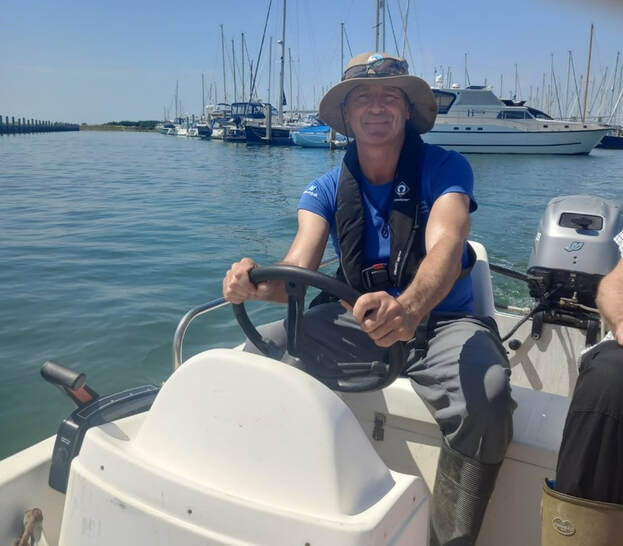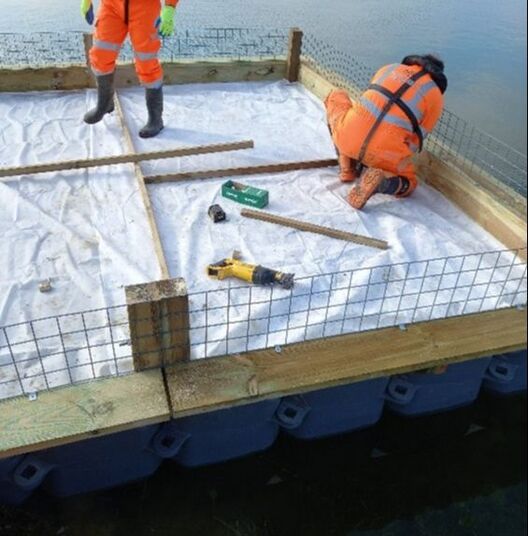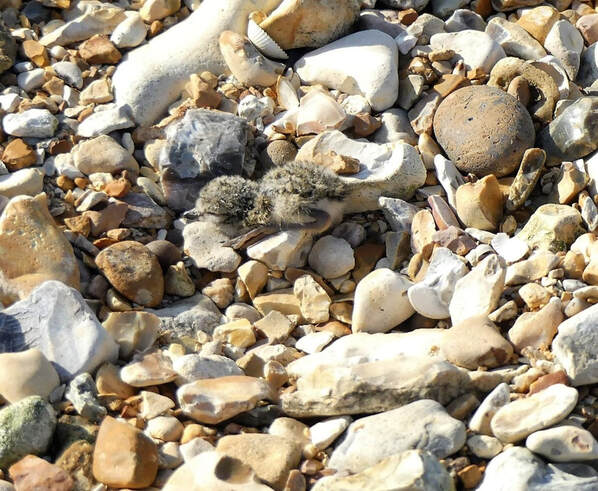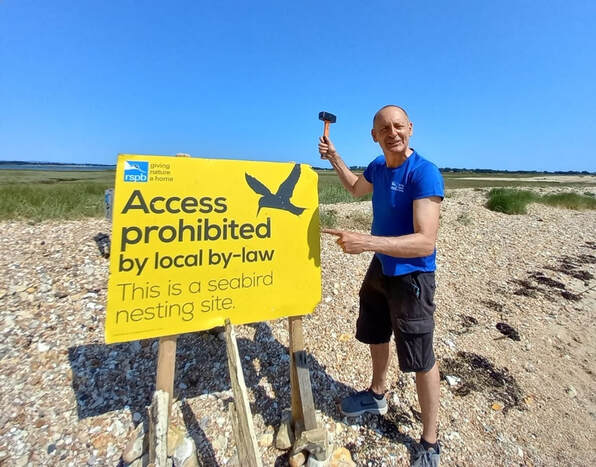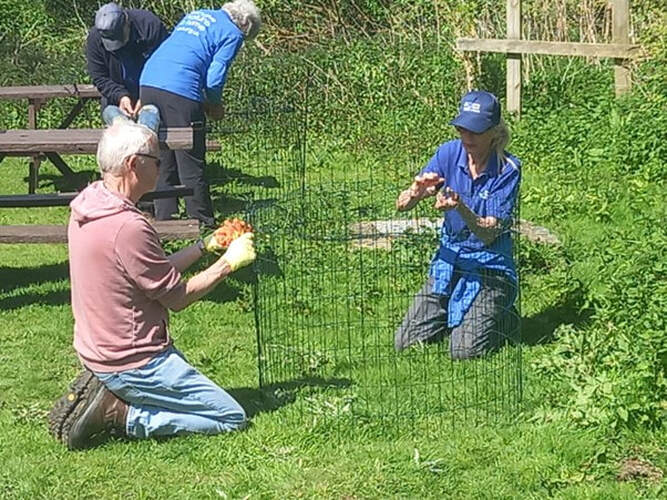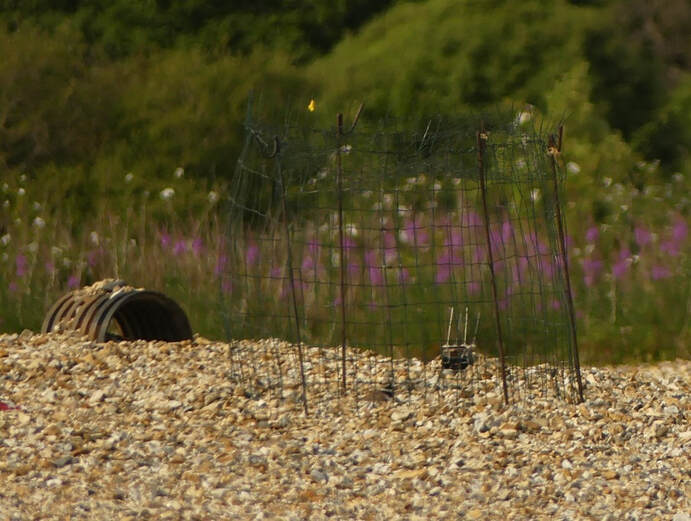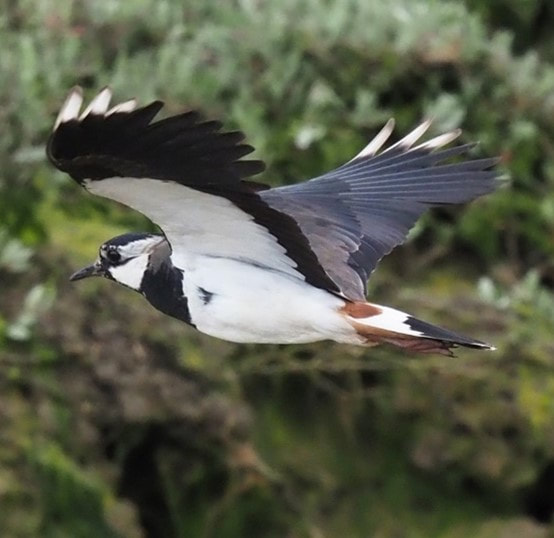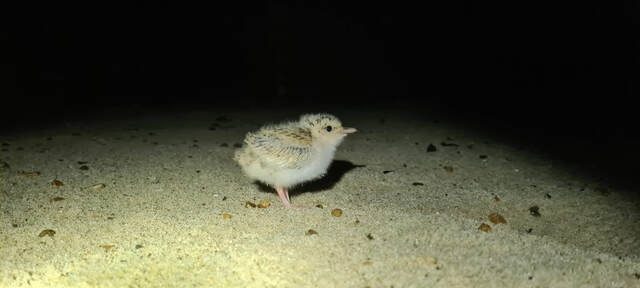|
Hello, my name is Mark Appleton and work as Beach Nesting Bird Project Officer along the Solent. I joined the RSPB in this role, this March 2023. So, what does a Beach Nesting Bird Project Officer do? I will attempt to explain some of the tasks I have undertaken so far. Thanks to the LIFE Programme (LIFE on the Edge) and the Solent Seascape Project, I was recruited to help change the fortunes of shore nesting birds on multiple sites, both on and off natures reserves across the Solent. This even includes working at the Browndown Military Training site. The area of Solent that I am responsible for ranges from Hurst Spit on the Western Solent to Pagham harbour on the Eastern Solent. Spread out across the Solent’s shingle and saltmarsh coasts, a diverse range of coastal ground-nesting birds make their home each summer. Ringed Plover, Oystercatcher and Little Tern regularly attempt nesting on our shingle beaches looking for new sites each year to raise a new generation as well as returning to old favourites. At the time of writing, we are in the very busy period where all our beach nesting birds are beginning to hatch, and a lot of my time is spent monitoring and trying to protect them Dense colonies of Sandwich Tern, Black-headed gull and Mediterranean Gulls take advantage of the water surrounded shingle and saltmarsh islands whilst common tern use a mixture of sites varying from man made structures to secluded shores. All these species are facing the growing challenge of fitting in on our very busy coasts. That’s where we are aiming to make a difference. I have been involved in the creation and deployment of these manmade structures, rafts for the common terns, working both with the RSPB Pagham wardens and volunteers to implement. Another part of the role is to develop, empower and support teams of volunteers to deliver shore nesting bird protection. Both the RSPB Pagham volunteers and RSPB Gunner point volunteers have been essential in providing support. Without them a lot of the jobs would not get done. At Hayling Island Gunner point this year we have continued developing the Ringed Plover Project that was set up by local conservationist Trevor Codlin. With the help of volunteers, we have cordoned off a section of the beach with mesh fencing to give Ringed Plover space to nest and bring up their chicks free from human and dog disturbance. The volunteers helped to install the fencing and regularly patrol the area to educate, raise awareness and inform visitors about how we can help Ringed Plover here by giving them lots of space and keeping away from fenced off areas so they can incubate their eggs without nest failures. I have created a Whatsapp group for the project so we can all provide each other updates on patrols and monitoring results. At the time of writing, we have had 3 successful nests with a total of 8 chicks with 2 very close to fledging. Unfortunately, our Ringed Plovers cant read and one family regularly wonders outside the fence. Only this week a dog was seen chasing the family and was only saved by the adult male luring the dog away by flying along the beach with the dog in close pursuit. This is why our brilliant volunteers are so important in raising awareness. To support our volunteer rangers I have created signage, a periodical update board and leaflets to inform the public. Deploying and creating signage is a very important part of the role as areas of prime nesting area need protecting Monitoring of breeding Ringed Plovers has identified that predation is one of the main factors in preventing hatching success. High levels of predation are likely to be exacerbated due to loss of good quality habitat, rising sea levels, and increasing human disturbance which could be resulting in birds nesting in sub optimal conditions and closer together. This year I have been part of the RSPB scientific study to test the effectiveness of nest cages on the hatching success of beach-nesting Ringed Plovers. So far the results are very encouraging and trail camera footage has shown protection from foxes, carrion crows, dogs, kestrel and even a tawny owl. An important part of the role is to continue building partnerships across a broad range of organizations so that we collaborate and achieve optimum success in trying to help nature. I try to provide updates and communication between organizations to achieve this and collaboration has include RSPB Pagham, Natural England at North Solent Nature Reserve, Hampshire Countryside Service at Lymington and Keyhaven Nature Reserve and Hook with Warsash , Browndown Military Training camp and many amazing volunteers. I hope this gives a flavour of some of the tasks involved with the role. If I had to summarise the role I would say: -
Buckler’s Hard Website: https://www.bucklershard.co.uk/events/conservation-awareness-day/ Facebook: https://fb.me/e/3h8QvEutw
Happy summer holidays but please remember to look out for our beach nesting birds and give them lots of space with dogs under close control 😊 Thank you for reading Mark
3 Comments
Blog by Louisa Claxton, RSPB Conservation Intern In March of this year, I started on an exciting new journey with RSPB Old Hall Marshes, as the conservation intern. Old Hall Marshes is situated on the Blackwater Estuary, it is comprised of ancient coastal grazing marsh and agriculturally improved grassland with reedbed and some scrubby areas. Grazing is an important part of managing the reserve is to keep the sward short which benefit breeding lapwing, their grazing pattern also has some great benefits for our redshanks by creating tussocks to build their nests inside. This means that it is currently an exciting time for everybody on the reserve. Chicks are hatching left right and centre, with fluffy lapwing, avocet and redshank chicks plodding about. Only a month ago I saw my first ever avocet chick, now I have counted over thirty-seven on site. Another highlight for me so far was coming across a redshank nest with four babies huddled together inside, amazing. Lapwings are a priority species on the reserve and are intensely monitored during the breeding season. We have two agriculturally improved wader fields, our primary wader field Bale and our secondary wader field Salcott. Since my arrival in March The reserve warden, Neil Lincoln and I have been monitoring lapwing nest and chick numbers daily on Salcott field. This involved scoping sitting lapwing from the seawall and directing the other person to the nests with questionable hand signals on my part. We then staked near the nests, assigned it a number, and recorded the number of eggs and GPS location. This field has shown to be successful for lapwing, from thirteen nests around fifteen chicks have been seen recently and many off these are almost fledged. The important task of monitoring lapwing nests on our primary field, bale field is done solely by one of our dedicated volunteers. Between the start of April and the end of May they recorded sixty-six nests and there are still more to be discovered. Bale field is ideal for breeding waders. A wind pump and drainable pipes maintain correct water levels for feeding chicks throughout the spring, and its permanent electric fence provides freedom from hungry badgers and foxes. Last year before I arrived, some exciting work was carried out by the European Union funded LIFE on the Edge project, with the creation and reprofiling of footdrains and raising of bunds to hold back more water. This has made this field even more attractive to breeding waders this year by holding water at different and variable depths across this field, opening up lots of feeding and foraging areas for young chicks. Further work is planned this autumn, which will be exciting. I am continually astonished and humbled by the level of biodiversity and the endangered species that flock to this site, seeing beautiful wildlife every day, such as, marsh harriers, cuckoos, egrets and many species of invertebrates is a privilege. I have enjoyed every minute of my internship here so far and have already gained lots of experience and skills in conservation. I am excited for what the rest of the internship will bring. Guest blog by Will Bevan, RSPB Field Officer (Norfolk) I’m sat in a tent on the beach in East Norfolk, sitting comfortably but chilly in a fold out camping chair with some strong coffee, engrossed in a book. My watch says that 2 A.M. has just crept by, and the sounds of the night reach out to me in my reverie. Waves are crashing softly in the distance, and the tent flaps lazily in a gentle breeze. Sand hoppers - tiny crustaceans with springy tails - scale the walls, falling to the floor as they throw themselves at the solar powered light in a cyclical pilgrimage which will last until dawn. Wailing seals and the hoarse barking of a muntjac deer form an eerie chorus, backed by the low hum of distant ships. Then I hear it: "KYEEEK!" The sound cuts through the night and my ears prick up - a little tern alarm call. "KYEEK! KYEEK!" The noise is unmistakable, and although I patrol the colony regularly, the terns are a reliable early warning system. I grab my torch and thermal imaging camera, unzip the tent door, and head out into the dark. As my eyes adjust, I fumble to turn on the camera, and through the grayscale display I can see the colony clearly. Directing it to the source of the commotion I can make out a large blob glowing white with body heat, which from experience could be one of two things - a fox, or a muntjac deer. Whilst both will eat little tern eggs, the foxes will go for chicks and adults, and it’s the latter I'm concerned about at this stage of the season. The colony is surrounded by an electrified fence and poultry netting for this very reason, but nearly all the chicks have now hatched, and they wander freely outside the perimeter. I set off in the direction of the blob, which is casually trotting along the boundary of the colony. The terns are becoming increasingly agitated as more birds join the fray, diving and shrieking at the unknown assailant. I trudge across the dunes that back the colony at a swift pace, brushing past dew-dropped marram grass and thistly sea-holly, which has recently erupted into a riot of silvery-blue flowers. The terns have now noticed me, and some direct their outrage at my head. I apologise profusely and assure them that I'm not the problem - if they would bother to listen - and work my way closer to the din. When I'm near enough for it to reach, I turn on the torch and shine it in the direction of the blob. If it was a fox, I would catch the glint of its eyes for a split second before it bolted away at full speed - but it isn't. Instead, a muntjac deer squints blearily at me through the beam of light, undeterred by my presence. A disturbance maybe, but no real threat at this point. Not wanting it to jump over the fence, I walk cautiously towards the deer and it sets off at a light jog, before slowing down to its original pace. In this way I escort it gradually to the edge of the colony, and it meanders off over the dunes and into the night. The terns have settled down and I turn back towards the tent, a lonely lamp under a cavernous night sky, the stars glimmering like precious minerals encrusted on its surface. A waning moon is rising behind wispy black clouds, casting an ethereal glow across the beach, and beyond the vast North Sea lies a barely perceptible hint of dawn. * * * * * * Three months ago, and thousands of miles away, somewhere in West Africa, a primeval urge has awakened within the mind of a small seabird. This bird - a little tern (Sternula albifrons) - is about to migrate North for the breeding season, where longer days and productive seas make for more ideal breeding conditions than where it is presently. This is a journey it might have undertaken many times before, with the oldest recorded individual clocking in at an incredible 26 years of age. It will arrive at its destination around the end of April, and whilst some of its companions might travel to places like Denmark or the Netherlands, this particular bird is heading for the East Norfolk coast. Around this time another migration is also underway, as I pack up the flat in mid-Wales where I have spent the last 16 months in lockdown to travel to the same East Norfolk coastline, and begin my role as a Beach-Nesting Bird Field Officer with the RSPB. This little tern will be joined by hundreds more, and for a few months our lives will be entwined as I and others attempt to give them the best chance of a successful breeding season. Norfolk is a crucial stronghold for the little tern in the UK, with colonies of varying size dotted along its stunning coastline, much of which is designated as an Area of Outstanding Natural Beauty (AONB). Low breeding success has resulted in a long-term decline of the population, and so the birds need a helping hand to fight back against this worrying downward trend. Amongst them also nest ringed plovers (Charadrius hiaticula), dumpy little wading birds which are also struggling to breed. Like other beach-nesting birds around the world, they are threatened by loss of habitat, human disturbance, predation, and climate change, the latter causing more frequent stormy weather and higher sea levels which can wash out whole colonies from their nests, which are dug precariously into the sand and gravel. The presence of night wardens is a key strategy in little tern conservation, as colonies need protection from a host of ground predators including foxes, hedgehogs, and muntjac deer. Sadly, egg thieves are still an issue, and so a presence on the beach at night is also a good deterrent to people who would do the breeding terns harm. As a cold and blustery May slipped into June and brought with it some fairer weather, the first little tern eggs of the season were spotted. It was at this time I began my first night shifts, and on a balmy evening at the end of May, I cycled through the idyllic Norfolk countryside to the colony as the light began to fade. The journey to and from shifts was always a delight, with plenty of wildlife about at those unsociable hours. On many occasions I saw hares, barn owls, and deer, as well the odd group of spoonbills and cranes flying overhead! As June progressed, I gradually adjusted to working in the dark as the sensations of the night became familiar to me, such as the night calls of passing redshank and common sandpipers, and the otherworldly churring of nightjars drifting over the dunes. The night has a way of eroding the senses, and it was both a surreal and profound experience to be out there on the edge of things, feeling at once isolated but also deeply connected to the rhythms of the Earth and the cosmos. The night skies in August were some of the most awe inspiring, and on occasion I would lie on the beach and gaze upwards, letting the brilliance of countless stars wash over me. One moment in particular stands out, at the height of the Perseid meteor shower, when with a flash the whole night sky was illuminated as a flaming ball of rock plunged through the atmosphere. This is the closest I have ever seen a meteor, and I stood dumbfounded for a moment as I processed what I had just witnessed. The immensity of this stage contrasted greatly with the job I was there to do - protecting these tiny seabirds and their even smaller chicks from whatever awaited them in the darkness. I grew extremely fond of the little terns and was lucky enough to spend time with them during the day, as well as at night. They are the most endearing birds, graceful in flight and striking to watch, with a gentle chattering that soothes the soul. They are also extremely hard working, and once their chicks began to hatch, journeyed back and forth to sea almost constantly from dawn until dusk, needing large quantities of nutritious fish to fuel the rapid growth of their offspring. I came to see myself as their babysitter at night and spent much of my time outside of work worrying about their wellbeing. I needn’t have worried though, as this year as always saw an excellent team of dedicated volunteers and field officers, who care deeply about the terns as I do. It is thanks to them that we had a successful breeding season, and to the public who visited our beaches this year and helped us to give space for these birds to thrive. As I reflect on the season, I look back fondly at my night shifts, and would encourage anyone who can to get out and find somewhere away from the lights to go and appreciate the night sky. The Norfolk Coast and Broads Dark Skies Festival is running now, from the 25th September until the 10th October 2021, with the Norfolk coastline boasting some of the darkest skies in the country thanks to the lack of artificial light nearby. For more information on all the amazing events taking place, head to the Norfolk AONB website! * * * * * * It’s mid-August, and I climb back inside the tent after the incident with the muntjac deer, settle down into the chair, and get stuck into my book again. Outside the terns begin to stir, and as they awaken for the day their chattering begins, and I head outside to join them. The clouds are pink with the light of dawn and the steadily rising sun is peeling itself off the horizon with a growing intensity. A large flock of little terns is congregated along the shoreline, with just as many in the air commuting to and from the colony. In their slender yellow bills with tips dipped in black they clutch glistening fish freshly plucked from the sea. They descend to the peeps of their fluffy, speckled chicks, which dive out of cover for the catch dangled before them. I take a breath - in a couple of weeks, the terns and their fledglings will be gone, flying back to West Africa until next year’s breeding season begins. With any luck the young ones will survive to live long lives, and maybe we will be reunited again here on the shifting shores of East Norfolk. As I stand captivated by the scene unfolding before me, a heavy fog begins to roll in off the sea, and the visibility quickly deteriorates. The tent is engulfed, and I can barely see the colony fence or the tent, leaving me alone on the shoreline with the sound of the terns and the crash of the waves as the world around us disappears. |
Archives
April 2024
Categories
All
Photo credits: Oystercatcher by Katie Nethercoat (rspb-images.com)
LOTE Logo credits: Saskia Wischnewski |

